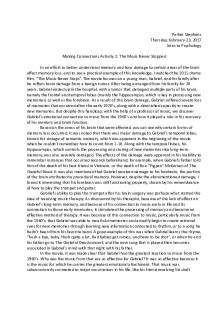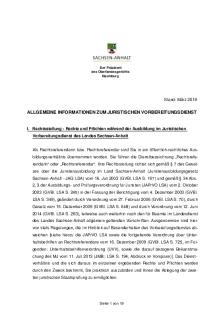Making Connections The Music Never Stopped PDF

| Title | Making Connections The Music Never Stopped |
|---|---|
| Author | Parker Stephens |
| Course | General Psychology |
| Institution | University of Utah |
| Pages | 2 |
| File Size | 37.1 KB |
| File Type | |
| Total Downloads | 79 |
| Total Views | 173 |
Summary
Making Connections Assignment: Summary and Review of the movie "The Music Never Stopped"...
Description
Parker Stephens Thursday, February 23, 2017 Intro to Psychology Making Connections Activity 2: The Music Never Stopped In an effort to better understand memory and how damage to certain areas of the brain affect memory loss, and to see a practical example of this knowledge, I watched the 2011 drama film, “The Music Never Stops”. The movie focuses on a young man, Gabriel, and his family after he suffers brain damage from a benign tumor. After being estranged from his family for 20 years, Gabriel ended up in the hospital, with a tumor that damaged multiple parts of his brain, namely the frontal and temporal lobes (mainly the hippocampus, which is key in processing new memories) as well as the forebrain. As a result of this brain damage, Gabriel suffered severe loss of memories that occurred after the early 1970’s, along with a diminished capacity to create new memories. But despite this handicap, with the help of a professor of music, we discover Gabriel’s emotional connection to music from the 1960’s and how it played a role in his recovery of his memory and brain function. Based on the areas of his brain that were affected, you can see why certain forms of memory loss occurred. It was noted that there was major damage to Gabriel’s temporal lobes, known for storage of semantic memory, which was apparent in the beginning of the movie when he couldn’t remember how to count from 1-10. Along with the temporal lobes, his hippocampus, which controls the processing and storing of new memories into long-term memory, was also severely damaged. The effects of the damage were apparent in his inability to remember instances that occurred seconds beforehand; for example, when Gabriel’s father told him of the death of his best friend in Vietnam, or the death of Ron “Pigpen” McKernen of The Grateful Dead. It was also mentioned that Gabriel received damage to his forebrain, the portion of the brain attributed to procedural memory. However, despite the aforementioned damage, I found it interesting that his forebrain was still functioning properly, shown by his remembrance of how to play the trumpet and guitar. Gabriel’s ability to play the trumpet after his brain surgery was perhaps what started the idea of receiving music therapy. As discovered by his therapist, because of the lack of effect on Gabriel’s long-term memory, and because of his connection to music early in life and its connection to those early memories, it stimulated the processing of memory and became an effective method of therapy. It was because of this connection to music, particularly music from the 1960’s, that Gabriel was able to recall old memories and actually begin to create retrieval cues for new memories through learning new information connected to rhythm, or to a song he hadn’t heard from his favorite band. A good example of this was when Gabriel learns the rhyme, “hush a bye, baby. Hush quite a lot. Bad babies get rabies, and have to be shot”, or when he and his father go to The Grateful Dead concert, and the new song that is played then becomes associated in Gabriel’s mind with that night with his father. In the movie, it was made clear that Gabriel had the greatest reaction to music from the 1960’s. Why was the music from that era so effective for Gabriel? It was so effective because it is the music for which he carries the greatest emotional attachment. That music was subconsciously connected to major occurrences in his life, like his friend receiving his draft
letter, his first time making love to his girlfriend, and even when his father kicked him out of the house. It was because of this emotional connection between the music and those important memories that caused such a dramatic response and became the pathway to Gabriel’s recovery....
Similar Free PDFs

Chapter 10 - Making Connections
- 16 Pages

Making Connections #3
- 2 Pages

Making+Karyotypes - the papert
- 7 Pages

Chemistry Connections
- 7 Pages

The Jewish Music
- 4 Pages

The Music of Indonesia
- 4 Pages

Never caught paper - history
- 5 Pages

The Scientist music coldplay
- 1 Pages

Bbyd connections
- 1 Pages

Apple in the Music Industry
- 15 Pages
Popular Institutions
- Tinajero National High School - Annex
- Politeknik Caltex Riau
- Yokohama City University
- SGT University
- University of Al-Qadisiyah
- Divine Word College of Vigan
- Techniek College Rotterdam
- Universidade de Santiago
- Universiti Teknologi MARA Cawangan Johor Kampus Pasir Gudang
- Poltekkes Kemenkes Yogyakarta
- Baguio City National High School
- Colegio san marcos
- preparatoria uno
- Centro de Bachillerato Tecnológico Industrial y de Servicios No. 107
- Dalian Maritime University
- Quang Trung Secondary School
- Colegio Tecnológico en Informática
- Corporación Regional de Educación Superior
- Grupo CEDVA
- Dar Al Uloom University
- Centro de Estudios Preuniversitarios de la Universidad Nacional de Ingeniería
- 上智大学
- Aakash International School, Nuna Majara
- San Felipe Neri Catholic School
- Kang Chiao International School - New Taipei City
- Misamis Occidental National High School
- Institución Educativa Escuela Normal Juan Ladrilleros
- Kolehiyo ng Pantukan
- Batanes State College
- Instituto Continental
- Sekolah Menengah Kejuruan Kesehatan Kaltara (Tarakan)
- Colegio de La Inmaculada Concepcion - Cebu





